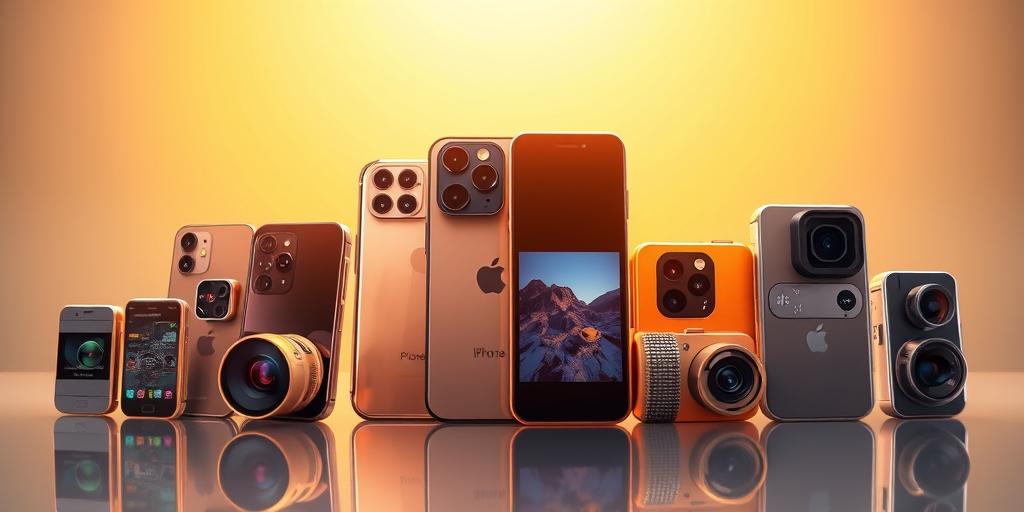Ever wondered how those stunning smartphone photos end up on your Instagram feed? The journey from blurry, pixelated images to the crisp, vibrant shots we see today is a fascinating technological odyssey. Prepare to be amazed as we delve into the electrifying history of camera technology in smartphones, revealing the innovations that transformed pocket-sized devices into powerful photographic tools. Buckle up, because this is one wild ride!
From Zero to Hero: The Dawn of Smartphone Cameras
The first smartphones with integrated cameras were, let’s just say, less than impressive. Remember those grainy, low-resolution images? These early cameras, often just a few megapixels, struggled in low light and lacked the features we take for granted today. Think Nokia’s early attempts or the first camera phones from companies like Sharp. But these early models represented a crucial first step, laying the groundwork for a future packed with innovation. Early designs often struggled with image quality and processing power, making even basic photography a challenge. But the mere concept of a camera-integrated mobile phone was revolutionary and set the stage for the incredible advancements we’re about to uncover. This foundational period, with its limitations, is crucial in understanding the extraordinary leap in technology that followed.
The Megapixel Race
The early 2000s saw a fierce competition: the megapixel race. Manufacturers constantly upped the resolution of their camera sensors, boasting ever-increasing numbers. While more megapixels didn’t automatically equate to better quality, it was a significant marketing point and did improve the potential resolution of images. This early era was marked by a rapid increase in megapixels, often outpacing the development of supporting image-processing technology. Companies competed aggressively in this space, leading to improvements in image sensors and image processing technology, although the focus remained heavily on megapixel counts.
The Rise of the Image Sensor: Capturing More Light
As technology advanced, the focus shifted from simply increasing megapixels to improving the image sensor itself. Larger sensors, particularly those found in smartphones from high-end manufacturers, resulted in better low-light performance, sharper images, and improved dynamic range. The development of CMOS (Complementary Metal-Oxide-Semiconductor) sensors was a particularly important milestone, offering advantages in power efficiency and speed over the older CCD (Charge-Coupled Device) technology. These improvements didn’t just affect image quality; they opened up possibilities for enhanced features, such as faster autofocus and the ability to capture better video. The evolution of the sensor remains one of the most crucial elements in the history of the smartphone camera.
Sensor Size Matters
The size of the image sensor directly affects image quality. Larger sensors allow for better light gathering, resulting in brighter and less noisy images, especially in low light conditions. However, larger sensors often mean bigger phone bodies, leading to a trade-off between image quality and phone design. The engineering challenges of incorporating larger sensors into increasingly compact smartphones have been continuous, pushing the boundaries of miniaturization and technological innovation.
Computational Photography: Beyond the Hardware
The advent of powerful mobile processors brought the field of computational photography to the forefront. Algorithms became as important as the hardware itself, allowing smartphones to perform impressive feats like HDR (High Dynamic Range) imaging, noise reduction, and advanced autofocus. Features such as AI-powered scene detection and computational zoom have dramatically transformed the photographic capabilities of smartphones. The focus has shifted from simply capturing the image to intelligently processing it to produce an optimal result, transforming the camera phone experience. This fusion of software and hardware remains a defining trend.
AI and the Future of Smartphone Photography
Artificial intelligence (AI) is rapidly changing the game. AI-powered features, such as automatic scene detection and subject tracking, create incredibly versatile tools that can adapt to changing conditions and subjects. AI is also used for advanced image processing, such as super-resolution and portrait mode with bokeh effects. The role of AI in mobile photography is ever expanding, pushing the boundaries of what’s possible, and showing no signs of slowing down. It’s truly an exciting time to be a smartphone photographer.
The Smartphone Camera Today and Beyond
Today’s smartphones boast incredible camera systems, often featuring multiple lenses with varying focal lengths and capabilities. Features like night mode, ultra-wide-angle lenses, and periscope zoom lenses, once considered the domain of professional cameras, are now commonplace. The integration of advanced image stabilization and video recording capabilities has solidified the smartphone’s place as a primary tool for both photography and videography. But the story doesn’t end here; the future of smartphone camera technology promises even more exciting advancements, driven by continued developments in sensor technology, AI, and computational photography.
From the humble beginnings of grainy, low-resolution images to the stunning visuals of today’s smartphone cameras, the journey has been nothing short of remarkable. The evolution showcases not only advancements in hardware but also the immense power of software and artificial intelligence. Are you ready to capture your own stunning memories with the latest innovations?




